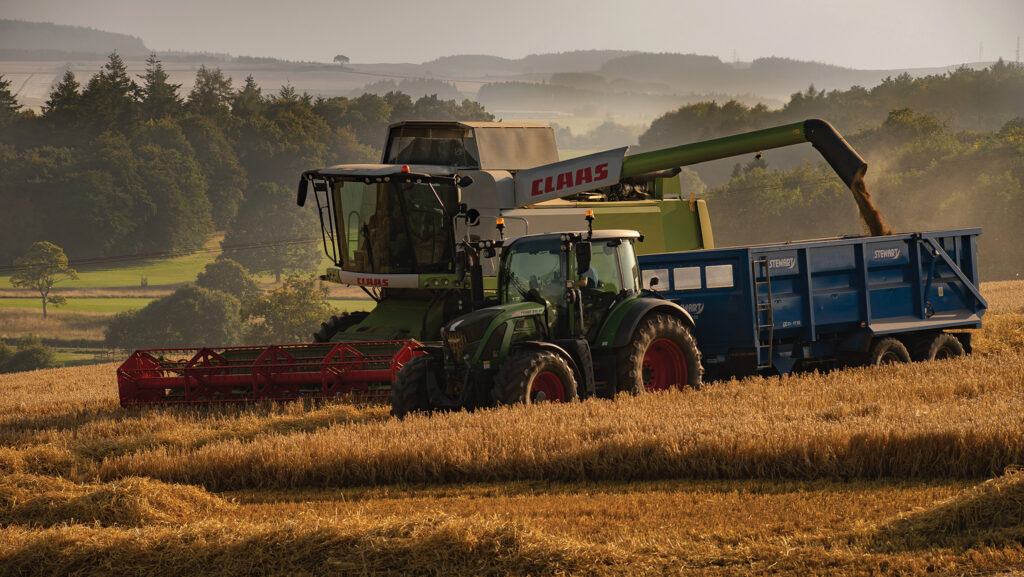Harvest 24: Final push to complete challenging Scottish harvest
 Hill of Tarvit Farm, Ceres, Fife © Toby-Malcolm
Hill of Tarvit Farm, Ceres, Fife © Toby-Malcolm As harvest wraps up for many in the South of the country, combines continue to roll in the North. Yields are still proving to be mixed, with most crops achieving respectable quality.
See also: Expert advice to improve soil fertility post-harvest
Scotland/Perthshire
Spring barley harvest is looking positive in Perthshire with combines about two thirds of the way through, says Robin Barron at East of Scotland Farmers.
“Yields are looking very healthy,” he says. “Nitrogen levels are low and there is good retention and excellent germination.”
The store has not seen much wheat yet, even though about three quarters has now been cut – but what has come, will be used for distilling and feed, with specific weights of 75kg/hl.
“Yields are variable,” he adds. “We are not at the stage where harvest is over, but what we have seen so far is variable. The weather forecast is looking good, and we expect the majority of it to be finished by the end of the week (w/c 16 September).”
Lincolnshire
In Lincolnshire about 95% of the wheat harvest is complete, but ergot is causing concern, says Simon Ingle, marketing director at Camgrain.
“There are high levels of ergot; I’ve not ever seen it on this scale,” he says.
However, he’s not seeing any issues with mycotoxins so far.
“Yields are a mixed bag, as to be expected from the varied drilling dates and weather conditions we have had.
“Some farmers are quite happy with their yields and others not so much, it depends on who you talk to.”
Protein levels are low, but all wheat is meeting the minimum specific weights of 74-76kg/hl for feed and 76-78kg/hl for milling.
“It’s looking like a good week ahead for the weather so I would expect that harvest will soon be done,” he added.
Co Durham and Northumberland
As harvest enters its final furlong, many people in the area are reporting one of the worst harvests in living memory, says Dave Young, farm buyer at Grainco.
He reports growers having winter wheat yields below 4.9t/ha at worst, and around 7.4t/ha at best. And while yields are well below the five-year average, specific weights have been respectable at 77-79kg/hl, with Hagberg exceeding 300.
“Proteins have been low at under 12%,” he adds.
Dave also notes that many growers were unable to complete their T0 and T1 fungicide applications because of poor weather.
“Varieties with a higher disease resistance did do better where those early applications were missed.”
Berwick-upon-Tweed
Bar 20ha of spring barley and some beans left to combine, harvest is almost complete for Jim Macfarlane at Edrington Mains Farm, near Edrington.
He describes the year as “average”, with crops producing variable yields. The 48ha of Diablo spring barley achieved between 5t/ha on the heavy land, and 7t/ha on lighter soils. Nitrogen content ranged from 1.4% to 1.55% with specific weights of 62kg/hl.
Winter barley was very poor and the 22ha of Craft yielded 6t/ha, says Jim.
“The potential was there, it just didn’t yield – although it did make malting specification.”
He would normally expect 8t/ha, so is opting to try a different variety – Buccaneer – next year.
Although it looked well in the field, the 48ha of Attica and Scorpion oilseed rape was variable at 3.5t/ha to 4.5t/ha.
The Zealum and Skyscraper winter wheat was a similar story.
“Yields were disappointing at 9t/ha, we usually average over 10t/ha. This is our last year with Skyscraper. I’ve drilled some Bamford, so I have high hopes for that.”
However, quality has been good and made distilling specification, with specific weights around 73kg/hl.
“I hope to get the bulk of the spring barley finished today (17 September). But the beans were drilled a month later than usual, so it will be October before we get into them.”

